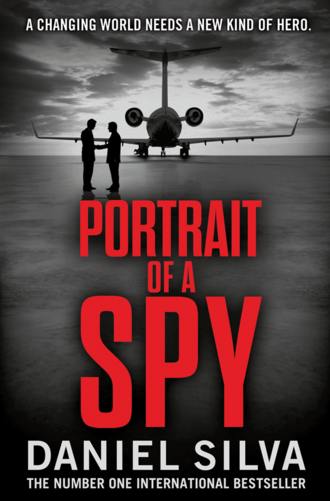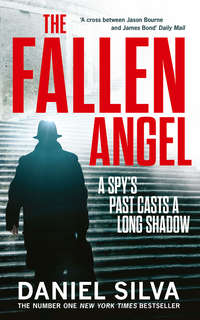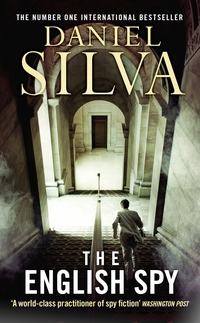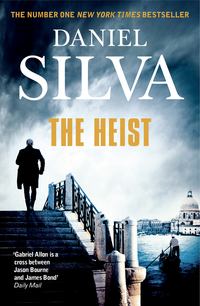
Полная версия
Portrait of a Spy

PORTRAIT OF A SPY
DANIEL SILVA

Dedication
For my wonderful children, Nicholas and Lily,
whom I love and admire more than they will
ever know. And, as always, for my wife, Jamie, who
makes everything possible.
Epigraph
Jihad is becoming as American as apple pie
and as British as afternoon tea.
ANWAR AL-AWLAKI, AL-QAEDA PREACHER AND RECRUITER
One person of integrity can make a difference,
a difference of life and death.
ELIE WIESEL
Contents
Title Page
Dedication
Epigraph
PART ONE
Chapter 1 - The Lizard Peninsula, Cornwall
Chapter 2 - Paris
Chapter 3 - St. James’s, London
Chapter 4 - Covent Garden, London
Chapter 5 - Covent Garden, London
Chapter 6 - Covent Garden, London
Chapter 7 - New Scotland Yard, London
Chapter 8 - New York City
Chapter 9 - The Lizard Peninsula, Cornwall
Chapter 10 - Lizard Point, Cornwall
Chapter 11 - Georgetown, Washington, D.C.
Chapter 12 - Georgetown, Washington, D.C.
Chapter 13 - Georgetown, Washington, D.C.
Chapter 14 - Georgetown, Washington, D.C.
Chapter 15 - Georgetown, Washington, D.C.
Chapter 16 - Georgetown, Washington, D.C.
Chapter 17 - Georgetown, Washington, D.C.
Chapter 18 - Georgetown, Washington, D.C.
Chapter 19 - Volta Park, Washington, D.C.
Chapter 20 - The Palisades, Washington, D.C.
PART TWO
Chapter 21 - New York City
Chapter 22 - Madrid-Paris
Chapter 23 - Paris
Chapter 24 - Paris
Chapter 25 - Seraincourt, France
Chapter 26 - Montmartre, Paris
Chapter 27 - Paris
Chapter 28 - Seraincourt, France
Chapter 29 - Seraincourt, France
Chapter 30 - Seraincourt, France
Chapter 31 - Seraincourt, France
Chapter 32 - Seraincourt, France
Chapter 33 - Seraincourt, France
Chapter 34 - St. James’s, London
Chapter 35 - Zurich
Chapter 36 - Lake Zurich
Chapter 37 - Lake Zurich
Chapter 38 - Paris
Chapter 39 - Zurich
Chapter 40 - Langley, Virginia
Chapter 41 - Riyadh, Saudi Arabia
Chapter 42 - Nejd, Saudi Arabia
Chapter 43 - Nejd, Saudi Arabia
Chapter 44 - St. James’s, London
Chapter 45 - St. James’s, London
Chapter 46 - Langley, Virginia
Chapter 47 - The Palisades, Washington, D.C.
PART THREE
Chapter 48 - The Plains, Virginia
Chapter 49 - The Plains, Virginia
Chapter 50 - The Plains, Virginia
Chapter 51 - The City, London
Chapter 52 - The City, London
Chapter 53 - The City, London
Chapter 54 - Dubai
Chapter 55 - Dubai International Airport
Chapter 56 - Burj Al Arab Hotel, Dubai
Chapter 57 - Langley, Virginia
Chapter 58 - Burj Al Arab Hotel, Dubai
Chapter 59 - Burj Al Arab Hotel, Dubai
Chapter 60 - Burj Al Arab Hotel, Dubai
Chapter 61 - Dubai
Chapter 62 - Deira, Dubai
Chapter 63 - The Empty Quarter, Saudi Arabia
Chapter 64 - The Empty Quarter, Saudi Arabia
Chapter 65 - The Empty Quarter, Saudi Arabia
Chapter 66 - The Empty Quarter, Saudi Arabia
PART FOUR
Chapter 67 - Paris-Langley-Riyadh
Chapter 68 - The Lizard Peninsula, Cornwall
Chapter 69 - New York City
Chapter 70 - Langley, Virginia
Chapter 71 - The Lizard Peninsula, Cornwall
Author’s Note
Acknowledgments
About the Author
Also by Daniel Silva
Copyright
About the Publisher
PART ONE
DEATH IN THE GARDEN
Chapter 1
The Lizard Peninsula, Cornwall
IT WAS THE REMBRANDT THAT solved the mystery once and for all. Afterward, in the quaint shops where they did their marketing and the dark little seaside pubs where they did their drinking, they would chide themselves for having missed the telltale signs, and they would share a good-natured laugh at some of their more outlandish theories about the true nature of his work. Because in their wildest dreams there was not one among them who ever considered the possibility that the taciturn man from the far end of Gunwalloe Cove was an art restorer, and a world-famous art restorer at that.
He was not the first outsider to wander down to Cornwall with a secret to keep, yet few had guarded theirs more jealously, or with more style and intrigue. A case in point was the peculiar manner in which he had secured lodgings for himself and his beautiful but much younger wife. Having chosen the picturesque cottage at the edge of the cliffs—by all accounts, sight unseen—he had paid the entire twelve-month lease in advance, with all the paperwork handled discreetly by an obscure lawyer in Hamburg. He settled into the cottage a fortnight later as if he were conducting a raid on a distant enemy outpost. Those who met him during his first forays into the village were struck by his notable lack of candor. He seemed to have no name—at least not one he was willing to share—and no country of origin that any of them could place. Duncan Reynolds, thirty years retired from the railroad and regarded as the worldliest of Gunwalloe’s residents, described him as “a cipher of a man” while other reviews ranged from “standoffish” to “unbearably rude.” Even so, all agreed that, for better or worse, the little west Cornish village of Gunwalloe had become a far more interesting place.
With time, they were able to establish that his name was Giovanni Rossi and that, like his beautiful wife, he was of Italian descent. Which made it all the more curious when they began to notice government-issue cars filled with government-issue men prowling the streets of the village late at night. And then there were the two blokes who sometimes fished the cove. Opinion was universal that they were the worst fishermen anyone had ever seen. In fact, most assumed they were not fishermen at all. Naturally, as is wont to happen in a small village like Gunwalloe, there began an intense debate about the true identity of the newcomer and the nature of his work—a debate that was finally resolved by Portrait of a Young Woman, oil on canvas, 104 by 86 centimeters, by Rembrandt van Rijn.
Precisely when it arrived would never be clear. They assumed it was sometime in mid-January because that was when they noticed a dramatic change in his daily routine. One day he was marching along the rugged cliff tops of the Lizard Peninsula as though wrestling with a guilty conscience; the next he was standing before an easel in his living room, a paintbrush in one hand, a palette in the other, and opera music blasting so loudly you could hear the wailing clear across Mount’s Bay in Marazion. Given the proximity of his cottage to the Coastal Path, it was possible—if one paused in just the right spot, mind you, and craned one’s neck at just the right angle—to see him in his studio. At first, they assumed he was working on a painting of his own. But as the weeks ground slowly past, it became clear he was involved in the craft known as conservation or, more commonly, as restoration.
“Hell’s that mean?” Malcolm Braithwaite, a retired lobsterman who smelled perpetually of the sea, asked one evening at the Lamb and Flag pub.
“It means he’s fixing the bloody thing,” said Duncan Reynolds. “A painting is like a living, breathing thing. When it gets old, it flakes and sags—just like you, Malcolm.”
“I hear it’s a young girl.”
“Pretty,” said Duncan, nodding his head. “Cheeks like apples. She looks positively edible.”
“Do we know the artist?”
“Still working on that.”
And work on it they did. They consulted many books, searched many sites on the Internet, and sought out people who knew more about art than they did—a category that included most of the population of West Cornwall. Finally, in early April, Dottie Cox from the village store screwed up the nerve to simply ask the beautiful young Italian woman about the painting when she came into town to do her marketing. The woman evaded the question with an ambiguous smile. Then, with her straw bag slung over her shoulder, she sauntered back down to the cove, her riotous dark hair tossed by the springtime wind. Within minutes of her arrival, the wailing of the opera ceased and the window shades of the cottage fell like eyelids.
They remained tightly closed for the next week, at which point the restorer and his beautiful wife disappeared without warning. For several days, the residents of Gunwalloe feared they might not be planning to return, and a few actually berated themselves for having snooped and pried into the couple’s private affairs. Then, while leafing through the Times one morning at the village store, Dottie Cox noticed a story from Washington, D.C., about the unveiling of a long-lost portrait by Rembrandt—a portrait that looked precisely like the one that had been in the cottage at the far end of the cove. And thus the mystery was solved.
Coincidentally, that same edition of the Times contained a front-page article about a series of mysterious explosions at four secret Iranian nuclear facilities. No one in Gunwalloe imagined there might be any connection. At least not yet.
The restorer was a changed man when he came back from America; they could see that. Though he remained guarded in his personal encounters—and he was still not the sort you would want to surprise in the dark—it was obvious a great burden had been lifted from his shoulders. They saw a smile on his angular face every now and again, and the light emitted by his unnaturally green eyes seemed a shade less defensive. Even his long daily walks had a different quality. Where once he had pounded along the footpaths like a man possessed, he now seemed to float atop the mist-covered cliffs like an Arthurian spirit who had come home after a long time in a distant land.
“Looks to me as if he’s been released from a sacred vow,” observed Vera Hobbs, owner of the village bakeshop. But when asked to venture a guess as to what that vow might have been, or to whom he had sworn it, she refused. Like everyone else in town, she had made a fool of herself trying to divine his occupation. “Besides,” she advised, “it’s better to leave him in peace. Otherwise, the next time he and his pretty wife leave the Lizard, it might be for good.”
Indeed, as that glorious summer slowly faded, the restorer’s future plans became the primary preoccupation of the entire village. With the lease on the cottage running out in September, and with no tangible evidence he was planning to renew it, they embarked on a covert effort to persuade him to stay. What the restorer needed, they decided, was something to keep him tethered to the Cornish coast—a job that utilized his unique set of skills and gave him something to do other than walk the cliffs. Exactly what that job might entail, and who would give it to him, they had no idea, but they entrusted to themselves the delicate task of trying to find it.
After much deliberation, it was Dottie Cox who finally hit upon the idea of the First Annual Gunwalloe Festival of Fine Arts, with the famous art restorer Giovanni Rossi serving as honorary chairman. She made the suggestion to the restorer’s wife the following morning when she popped into the village store at her usual time. The woman actually laughed for several minutes. The offer was flattering, she said after regaining her composure, but she didn’t think it was the sort of thing Signor Rossi would agree to. His official rejection came soon after, and the Gunwalloe Festival of Fine Arts quietly withered on the vine. It was no matter; a few days later, they learned that the restorer had taken the cottage for another year. Once again, the lease was paid in full, with all the paperwork handled by the same obscure lawyer in Hamburg.
With that, life returned to something like normal. They would see the restorer in mid-morning when he came to the village with his wife to do their marketing, and they would see him again in mid-afternoon when he hiked along the cliff tops in his Barbour coat and his flat cap pulled low over his brow. And if he failed to give them a proper greeting, they took no offense. And if he seemed uneasy about something, they gave him room to work it out on his own. And if a stranger came to town, they tracked his every move until he was gone. The restorer and his wife might have come from Italy originally, but they belonged to Cornwall now, and heaven help the fool who ever tried to take them away again.
There were, however, some on the Lizard who believed there was more to the story—and one man in particular who believed he knew what it was. His name was Teddy Sinclair, owner of a rather good pizzeria in Helston and a subscriber to conspiracy theories large and small. Teddy believed the moon landings were a hoax. Teddy believed 9/11 was an inside job. And Teddy believed the man from Gunwalloe Cove was hiding more than a secret ability to heal paintings.
To prove his case once and for all, he summoned the villagers to the Lamb and Flag on the second Thursday of November and unveiled a chart that looked a bit like the periodic table of elements. It purported to establish, beyond a shadow of a doubt, that the explosions at the Iranian nuclear facilities were the work of a legendary Israeli intelligence officer named Gabriel Allon—and that the same Gabriel Allon was now living peacefully in Gunwalloe under the name Giovanni Rossi. When the laughter finally died down, Duncan Reynolds called it the dumbest thing he’d heard since some Frenchman decided that Europe should have a common currency. But this time Teddy stood his ground, which in hindsight was the right thing to do. Because Teddy might have been wrong about the moon landings, and wrong about 9/11, but when it came to the man from Gunwalloe Cove, his theory was in every respect true.
The next morning, Remembrance Day, the village woke to the news that the restorer and his wife had disappeared. In a panic, Vera Hobbs hurried down to the cove and peered through the windows of the cottage. The restorer’s supplies were scattered across a low table, and propped on the easel was a painting of a nude woman stretched upon a couch. It took Vera a moment to realize that the couch was identical to the one in the living room, and that the woman was the same one she saw each morning in her bakeshop. Despite her embarrassment, Vera couldn’t seem to summon the will to look away, because it happened to be one of the most strikingly beautiful paintings she had ever seen. It was also a very good sign, she thought as she headed back to the village. A painting like that was not the sort of thing a man left behind when he was making a run for it. Eventually, the restorer and his wife would come back. And heaven help that bloody Teddy Sinclair if they didn’t.
Chapter 2
Paris
THE FIRST BOMB EXPLODED AT 11:46 a.m., on the Avenue des Champs-Élysées in Paris. The director of the French security service would later say he received no warning of the impending attack, a statement his detractors might have found laughable were the death toll not so high. The warning signs were plain to see, they said. Only the blind or the willfully ignorant could have possibly missed them.
From Europe’s point of view, the timing of the attack could not have been worse. After decades of lavish social spending, much of the Continent was teetering on the brink of fiscal and monetary disaster. Its debt was soaring, its treasuries were empty, and its pampered citizenry was aging and disillusioned. Austerity was the order of the day. In the current climate, no cow was considered too sacred; health care, university tuition, support for the arts, and even pension benefits were all undergoing drastic cuts. Along Europe’s so-called periphery, the smaller economies were falling like dominoes. Greece was sinking slowly into the Aegean, Spain was on life support, and the Irish Miracle had turned out to be nothing more than a mirage. In the smart salons of Brussels, many Eurocrats were daring to say aloud what had once been unthinkable—that the dream of European integration was dying. And in their darker moments, a few of them actually wondered whether Europe as they knew it might be dying, too.
Another article of faith lay in tatters that November—the belief that Europe could absorb an endless tide of Muslim immigrants from its former colonies while preserving its culture and basic way of life. What had started as a temporary program to relieve a postwar labor shortage had now permanently altered the face of an entire continent. Restive Muslim suburbs ringed nearly every city, and several countries appeared demographically fated to Muslim majorities before the end of the century. No one in a position of power had bothered to consult the native population of Europe before throwing open the doors, and now, after years of relative passivity, the natives were beginning to push back. Denmark had imposed draconian restrictions on immigrant marriages. France had banned the wearing of the full facial veil in public. And the Swiss, who barely tolerated one another, had decided they wanted to keep their tidy little cities and towns free of unsightly minarets. The leaders of Britain and Germany had declared multiculturalism, the virtual religion of post-Christian Europe, a dead letter. No longer would the majority bend to the will of the minority, they declared. Nor would it turn a blind eye to the extremism that flourished within its midst. Europe’s age-old contest with Islam, it seemed, had entered a new and potentially dangerous phase. There were many who feared it would be an uneven fight. One side was old, tired, and largely content with itself. The other could be driven into a murderous frenzy by a doodle in a Danish newspaper.
Nowhere were the problems facing Europe on clearer display than in Clichy-sous-Bois, the volatile Arab banlieue located just outside Paris. The flashpoint for the deadly riots that swept France in 2005, the suburb had one of the country’s highest unemployment rates, along with one of the highest rates of violent crime. So dangerous was Clichy-sous-Bois that even the French police refrained from entering its seething public housing estates—including the one where Nazim Kadir, a twenty-six-year-old Algerian employed by the celebrated Fouquet’s restaurant, lived with twelve other members of his extended family.
On that morning in November, he left his apartment in darkness to purify himself at a mosque built with Saudi money and staffed by a Saudi-trained imam who spoke no French. After completing this most important pillar of Islam, he rode a 601AB bus to the suburb of Le Raincy and then boarded an RER train to the Gare Saint-Lazare. There he switched to the Paris Métro for the final leg of his journey. At no point did he arouse the suspicions of the authorities or his fellow passengers. His heavy coat concealed the fact he was wearing an explosive vest.
He emerged from the George V stop at his usual time, 11:40, and started up the Avenue des Champs-Élysées. Those lucky enough to survive the inferno to come would later say there was nothing unusual in his appearance, though the owner of a popular flower shop claimed to notice a curious determination in his gait as he closed in on the entrance of the restaurant. Among those standing outside were a deputy minister of justice, a newsreader from French television, a fashion model currently gracing the cover of Vogue magazine, a Gypsy beggar clutching the hand of a small child, and a noisy group of Japanese tourists. The bomber made one final check of his watch. Then he unzipped his coat.
It was never clearly established whether the act was preceded by the traditional scream of “Allahu Akbar.” Several survivors claimed to have heard it; several others swore the bomber detonated his device in silence. As for the sound of the explosion itself, those closest had no memory of it at all, for their eardrums were too badly damaged. To a person, all recalled seeing a blinding white flash of light. It was the light of death, said one. The light one sees at the moment he confronts God for the first time.
The bomb itself was a marvel of design and construction. It was not the kind of device built from Internet manuals or the how-to pamphlets floating around the Salafist mosques of Europe. It had been perfected under battle conditions in Palestine and Mesopotamia. Packed with nails soaked in rat poison—a practice borrowed from the suicide bombers of Hamas—it carved through the crowd like a circular saw. So powerful was the explosion that the Louvre Pyramid, located a mile and a half to the east, shivered with the blast wave. Those closest to the bomber were blown to pieces, sheared in half, or decapitated, the preferred punishment for unbelievers. Even at forty paces, limbs were lost. At the farthest edge of the kill zone, the dead appeared pristine. Spared outward trauma, they had been killed by the shock wave, which ravaged their internal organs like a tsunami. Providence had granted them the tender mercy of bleeding to death in private.
The first gendarmes to arrive were instantly sickened by what they saw. Extremities littered the paving stones, along with shoes, smashed wristwatches frozen at 11:46, and mobile phones that rang unanswered. In one final insult, the murderer’s remains were scattered among his victims—everything but the head, which came to rest on a delivery truck more than a hundred feet away, the bomber’s expression oddly serene.
The French interior minister arrived within ten minutes of the explosion. Seeing the carnage, he declared, “Baghdad has come to Paris.” Seventeen minutes later, it came to the Tivoli Gardens in Copenhagen, where, at 12:03 p.m., a second suicide bomber detonated himself amid a large group of children waiting impatiently to board the park’s roller coaster. The Danish security service, the PET, quickly established that the shahid had been born in Copenhagen, had attended Danish schools, and was married to a Danish woman. It seemed not to trouble him that his own children attended the same school as his victims.
For the security professionals across Europe it was the nightmare scenario come true—coordinated and highly sophisticated attacks that appeared to have been planned and executed by a skilled mastermind. They feared the terrorists would strike again soon, though two critical pieces of information eluded them. They did not know where. And they did not know when.
Chapter 3
St. James’s, London
LATER, THE COUNTERTERRORISM COMMAND OF London’s Metropolitan Police Service would expend much valuable time and effort trying to reconstruct the movements that morning of one Gabriel Allon, the legendary but wayward son of Israeli intelligence, now formally retired and living quietly in the United Kingdom. It is known, based on eyewitness accounts from his meddlesome neighbors, that he departed his cottage in Cornwall a few minutes after dawn and climbed into his Range Rover, accompanied by his beautiful Italian-born wife, Chiara. It is also known, due to Britain’s Orwellian system of CCTV cameras, that the couple reached central London in near-record time, and that, through an act of divine intervention, they managed to find a somewhat legal parking space in Piccadilly. From there they proceeded on foot to Mason’s Yard, a tranquil quadrangle of paving stones and commerce in St. James’s, and presented themselves at the door of Isherwood Fine Arts. According to the CCTV camera in the yard, they were admitted into the premises at 11:40 London time, though Maggie, Isherwood’s latest mediocre secretary, would erroneously record the time in her logbook as 11:45.







